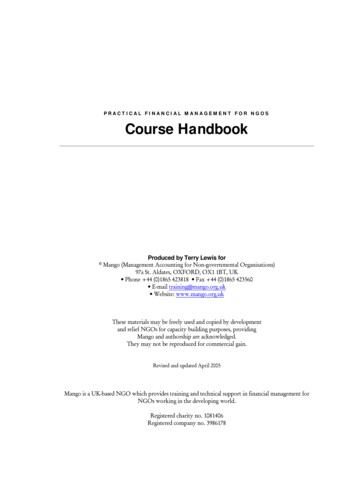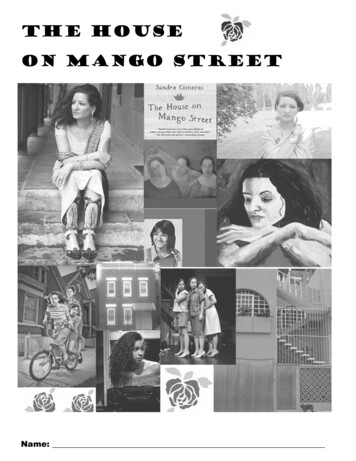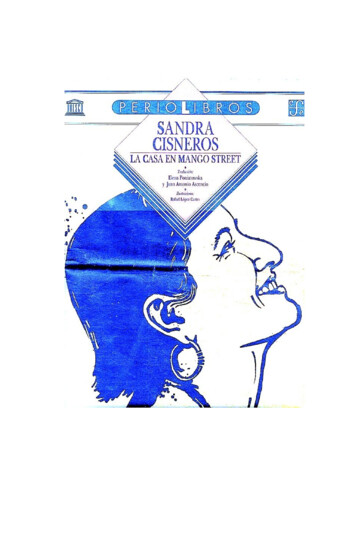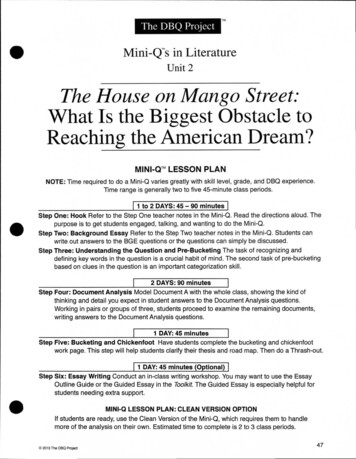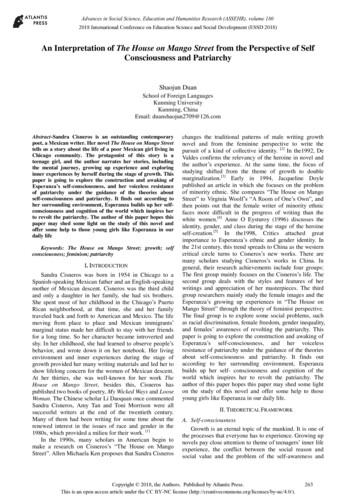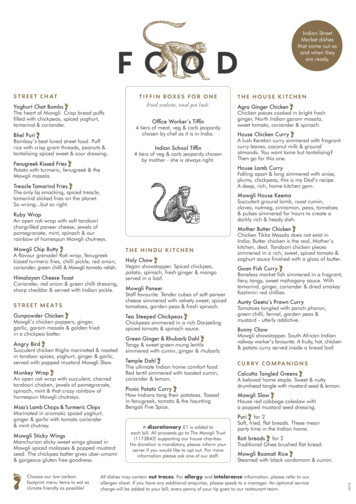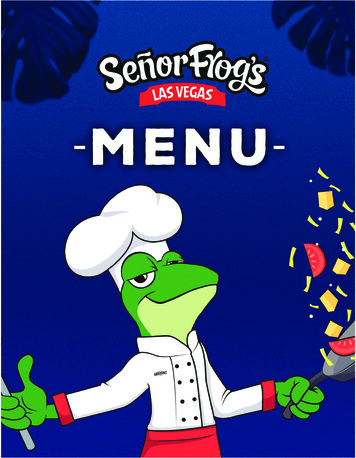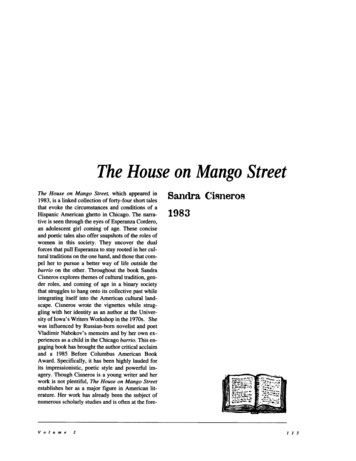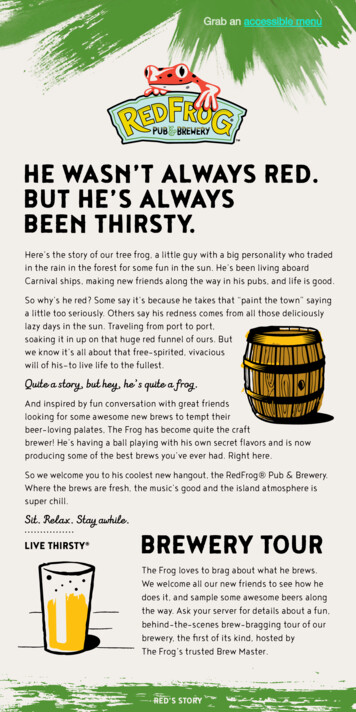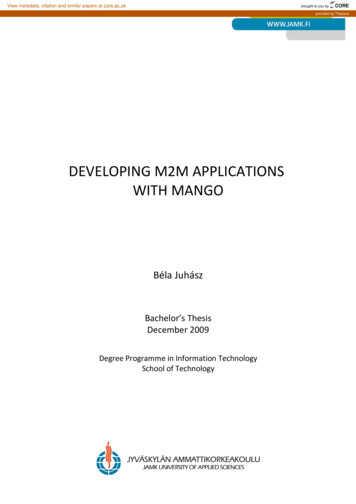
Transcription
View metadata, citation and similar papers at core.ac.ukbrought to you byCOREprovided by TheseusDEVELOPING M2M APPLICATIONSWITH MANGOBéla JuhászBachelor’s ThesisDecember 2009Degree Programme in Information TechnologySchool of Technology
Author(s)JUHÁSZ, BélaType of publicationBachelor s tialPermission for webpublication(X)( ) UntilTitleDEVELOPING M2M APPLICATIONS WITH MANGODegree ProgrammeInformation TechnologyTutor(s)PELTOMÄKI, JuhaAssigned byJAMK University of Applied SciencesAbstractMango is an open source alternative for Machine to Machine software. It enables users toaccess and control electronic sensors, devices, and machines over multiple protocolssimultaneously. However, Mango was designed for the desktop. It relies heavily onJavaScript to render its graphical pages. While rendering, massive amounts of data arebeing transferred between the Mango server and the browser. Furthermore, because of thecontinuous polling for new data, it can easily hog the CPU of the computer displaying saiddata. As a result of these limitations, Mango is hardly usable on a wide range of – mainlyolder – mobile devices.The commissioners of the project at the JAMK University of Applied Sciences wanted toinvestigate the possibility of other means of accessing the data collected by Mango.Specifically, the software had to be examined and documented if it was achievable to accessthe data directly by an external lightweight application written in, for example, PHP.The analysis showed that because of the nature how Mango stores many of its crucial data –by serializing Java objects into BLOB columns – direct access poses challenges. However,with the help of Mango's ability to serialize objects into JSON format, a new path opens todevelopers aiming for mobile access.KeywordsMango, M2M, Machine to Machine, Java, JSON, Spring.Miscellaneous
1CONTENTS1 OBJECTIVE OF THE PROJECT.52 MANGO M2M SERVER APPLICATION.62.1 Main concepts in Mango.72.2 Installation.112.3 Compilation.112.4 Software components used.133 SPRING WEB MVC.143.1 The MVC architecture .143.2 Request processing in Spring MVC .153.3 Handler mappings.183.4 Controllers .183.5 Views.223.6 Ajax with DWR.233.7 Analysis of a request.244 DATABASE STRUCTURE IN MANGO.304.1 Tables visualized.304.2 Data access layer.315 AN EXAMPLE MODIFICATION .355.1 The task.355.2 Implementation.366 CONCLUSION.39REFERENCES.40
2FIGURESFIGURE 1. Graphical representations of sensorsFIGURE 2. An example DataSource with DataPointsFIGURE 3. Details and actual values of a data pointFIGURE 4. Watch listFIGURE 5. Graphical viewFIGURE 6. The mobile version of the watch list shown in Figure 4FIGURE 7. The request processing workflow in Spring Web MVCFIGURE 8. The most important tables in MangoFIGURE 9. The details of an HTTP Retriever DataSourceFIGURE 10. An HTTP Image DataSource and its DataPointFIGURE 11. The clickable rendered imageTERMINOLOGYMachine to MachineMachine to Machine (often abbreviated as M2M) refers to data communicationsbetween machines. The term also means the complexity of sensors which producedata, the communications channel which connects the sensors to a server computer
3and a software running on the server, having the task to analyse and report thecollected data. Sometimes the same software is capable of intervening into theprocess. (Machine to Machine 2009.)Open source softwareOpen source software is a computer software where the source code is provided undera software license that meets the Open Source Definition or it is in the public domain.Open source software therefore can be edited, modified and then redistributed freely,given certain conditions are met (e.g. not placing the software under a more restrictivelicense, providing the license with the software, etc.) (Open Source Initiative 2009.)MangoThe open-source Mango software is one – although a crucial – element of a wholeM2M system. Its role is to gather and process data, present this raw data in a waywhich is comprehensible to a human operator who can, in turn, send commands andthus control the process: Mango is an “open source alternative for Machine-toMachine (M2M) software [.]. Mango is browser-based, Ajax-enabled M2M softwarethat enables users to access and control electronic sensors, devices, and machines overmultiple protocols simultaneously.” (Mango, open source M2M 2009.)MVCMVC is the acronym for the Model–View–Controller (MVC) architectural patternused in software engineering. The purpose of this pattern is to simplify theimplementation of applications that need to act on user requests and manipulate anddisplay data. The model is the data to be presented to the user. The view part is incharge of rendering the model in a suitable manner. And lastly, the controller isresponsible for processing and acting on user requests. It loads and prepares themodel, chooses the appropriate view and finally passes the model to the chosen viewfor rendering. (Machacek, Vukotic, Chakraborty & Ditt 2008, 611.)Spring's Web MVC framework
4Spring is an open source framework, created by Rod Johnson. It was created toaddress the complexity of enterprise application development. With a more technicaldescription one could describe it as a lightweight dependency injection and aspectoriented container and framework. For a more in-depth analyses of Spring, refer toWalls 2008. The Spring framework is made up of several well-defined modules builton top of the core container. Such modules are for example the ORM integrationmodule, JMX module, JDBC abstraction and the DAO module. The Spring Web MVCframework is just one of these modules, implementing the MVC architectural pattern.(Ladd, Donald 2006, 7.)Direct Web Remoting“DWR, which is short for Direct Web Remoting, is a Java-based Ajax framework thatlets you access virtually any server-side Java object through JavaScript. DWRabstracts XMLHttpRequest away so that invoking methods on a server-side Javaobject is as simple as invoking methods on a client-side JavaScript object.” (Walls2008, 650.) DWR dynamically converts the server-side Java objects into JavaScriptones that implement the same interface as the original Java objects. The JavaScriptlibraries are also responsible for sending XMLHttpRequests from the browser to theserver and dynamically updating the web page with the data sent back.Dojo JavaScript toolkitDojo is an open source JavaScript framework that simplifies Ajax programming. It is acollection of JavaScript components to assist building JavaScript applications.
51 OBJECTIVE OF THE PROJECTOriginally, Mango was designed for the desktop. It relies heavily on JavaScript torender its graphical pages. While rendering, massive amounts of data are beingtransferred between the Mango server and the browser. Furthermore, because of thecontinuous polling for new data, it can easily hog the CPU of the computer displayingsaid data. As a result of these limitations, Mango is hardly usable on a wide range of –mainly older – mobile devices. Mobile devices tend to be slow, memory is alwaysscarce and the size of the display is barely enough to show the graphical viewsoriginally created for a high-resolution monitor of a desktop computer.Fortunately, with the arrival of the latest version of Mango (1.7.0), a very simplemobile WatchList has appeared in the program. It is a much simplified version of theoriginal WatchList page and was written with mobile devices in mind. However, itlacks many of the functionalities needed by the commissioners of the project at theJAMK University of Applied Sciences, therefore there was a need that someoneimplemented those requirements.Among these requirements is the ability to attach simple event detectors to point values with theaccompanying event handlers a mobile WatchList specifically written to a certain type of mobile phone mass-creation of DataSources the ability of uploading pictures (to make WatchLists easier to be identified) the possibility of directly accessing the data stored in Mango from – forexample – PHP using the data in an external application after having it exported into JSON
6format.For all this to be completed, one has to first understand and document the system. Thisthesis aims to be the first step towards that goal. The task of the author of this thesiswas to discover how Mango works beneath the covers, to document it and, if it ispossible, to make some minor modifications to the system.2 MANGO M2M SERVER APPLICATIONAs stated before, Mango is one important element of a complete M2M system. Itprovides a database to store the collected data, a Human-Machine Interface to providegraphs, diagnostic data, and management information. Mango can present theinformation to the operating personnel in an easy to use graphical interface, in theform of a mimic diagram. For example, a picture of a thermometer can show theoperator the temperature of the room where one of the sensors is located.FIGURE 1. Graphical representations of sensorsFurthermore, it enables the administrator to set up alarms on specific events, to logthese events, and to react to these events in an automated fashion. The system isdesigned for multiple users: it has a sophisticated user management system, where onecan finely tune what ordinary users can see and do.Mango is a highly-regarded software in the world of M2M automation. Being open
7source, the program is not just free, but is also freely available for any modification.It must be admitted, that it also has some disadvantages, too. The code got verycomplex over the years, it seems to be developed by only one person and the usercommunity is everything but large. Still, currently it is one of the best free solution tobe found on the market.2.1 Main concepts in MangoThough the task is to describe Mango from a developer's point of view (and not froma user's), the main concepts of the system need to be presented, because they will bereferred to on several occasions.Collecting data begins with setting up a “data source”. Different kind of data sourcesare available, based on their underlying protocol for gathering data. Examples forprotocols are Modbus IP, Modbus Serial, 1-wire, SNMP. Mango can also receive datathrough HTTP: it can download an image, and it is able to parse HTML, so with thehelp of a well-formed regular expression, one can easily extract valuable information(e.g. temperature data) from any web page (website of a weather station). Relatedsource files are com.serotonin.mango.rt.dataSource.DataSourceRT andcom.serotonin.mango.vo.dataSource.DataSourceVO. DataSourceVOrepresents the configuration of a DataSourceRT, and it is the DataSourceVO whoseparameters can be set at the data source edit.shtm. DataSourceRT is only aninterface for the specific data sources implemented under the/src/com/serotonin/mango/rt/dataSource directory.
8FIGURE 2. An example DataSource with DataPointsAfter setting up a data source, one must define so-called “data points”. One datasource can have many different data points. A physical measurement device (a datasource, that is) can, for example, supply data about the temperature, the humidity andthe brightness of a room. The latter three objects are the data points. It is crucial not toconfuse data points with their actual values: a data point is simply a concept (i.e.humidity), while its value will be 10%. Data points thus have data point values. Datapoints do not change, only their values do. Interesting files are the erotonin.mango.rt.dataImage.DataPointRT andcom.serotonin.mango.db.dao.DataPointDao. The actual values are representedby the com.serotonin.mango.rt.dataImage.PointValueTime class, and arehandled by the following eFacade andcom.serotonin.mango.db.dao.PointValueDao.
9FIGURE 3. Details and actual values of a data pointOne can examine and follow these data points (and their values) by using “watch lists”or “graphical views”. Watch lists are a tabular set of points that one wishes to view allat once. Point values and value times update automatically, there is no need to refreshthe page.FIGURE 4. Watch listA graphical view is similar to a watch list, but instead provides a graphicalrepresentation of selected points. The representation of each point in one's viewdepends upon that point's configuration. Points can be rendered as simply a currentvalue (like in a watch list), or an arbitrary icon set can be used that visually representsthe point's value (e.g. a thermometer showing the temperature). Graphical views arevisually more pleasing to the eye.
10FIGURE 5. Graphical viewFor example, graphical views may optionally be presented upon background images.In this thesis the emphasis is on watch lists, so for now, the interesting classes .mango.web.dwr.WatchListDwr andcom.serotonin.mango.db.dao.WatchListDao. With the 1.7.0 release of Mango,a new concept, the so-called “mobile watch lists”, has appeared. These are simplified,lightweight versions of the original heavyweight watch lists. Normal watch lists usemassive amount of JavaScript, they are slow or sometimes even unable to load onmobile devices, that is why something lighter was leWatchListControllerand ListState arethe most important classes here.
11FIGURE 6. The mobile version of the watch list shown in Figure 4Mango provides a robust and highly configurable event management system, whereusers can programmatically react to specific events. One can define and attach an“event detector” to a data point (for example, the temperature of the room exceeded acertain limit), after which the “event handling” system kicks in and alerts those users(by email), who are subscribed for this type of event.2.2 InstallationInstallation is fairly straightforward, although not without problems. Instructions canbe found on the Mango ad.jsp), solutions for commoninstallation problems are in the 3 CompilationThe main objective is to modify the Mango source code in a way so that it is usable onmobile devices. Mango, fortunately being an open source application, comes with itsown source code. At the time of writing this thesis, the source is distributed as a zippackage, although there are plans to host it in a repository of a revision controlsystem. The current maintainer uses Eclipse as his main development tool, but notwanting to force the reader to use this specific IDE, the author of this thesis chose touse only a simple text-editor and the command-line armed with ant. To be able to
12compile it, the following modifications had to be made to the source code: In the file MANGO HOME/build.properties: tomcat.homeThis is the directory where Tomcat is residing, e.g./home/user/opt/tomcat6 tomcat.manager.username tomcat.manager.password tomcat.appdirThe name of the directory where the compiled Mango will be deployed to.In this example it is mango17. tomcat.apppathThe absolute path of the directory (relative from the the webappsdirectory of Tomcat) where the compiled Mango will be deployed to. Inthis example it is /mango17. db.url Download RXTXcomm.jar from the Mango homepage and put it in MANGO HOME/lib Download axis-ant.jar (for example from the apache.org website orfrom your Eclipse distribution) and put it in MANGO HOME/lib Delete the MANGO afile. This is only a test file, which unfortunately did not compile, and fixing itwould take too much time. It is safe to delete.
13 Copy the MANGO HOME/build.properties to MANGO HOME/war/WEBINF/classes/env.properties, modify its contents to look similar to this,then adjust the db.url property according to your setup.db.type derbydb.url /mangoDBdb.username db.password db.pool.maxActive 10db.pool.maxIdle 10convert.db.type convert.db.url convert.db.username convert.db.password grove.url http://mango.serotoninsoftware.com/ servletRemark: MANGO HOME is the directory where the source code has been extracted to.After all these changes have been made, issuing an ant and ant reload commandshould run without problems.2.4 Software components usedThe newest available release of Mango is at version 1.7.0. Since there is no publicsource code repository, there are no other (unstable) releases either.At the time of writing this thesis, the newest release of Mango uses the followingsoftware components and frameworks: Spring's Web MVC framework, version 2.5.3, http://www.springsource.org
14 Direct Web Remoting, version 2.0.1, http://directwebremoting.org/dwr/ Dojo JavaScript toolkit, version 0.4.2, . According to the author of Mango, the reason forusing such an outdated version is that updating to a newer one would be a hardand tedious task. Moreover, since the current version functions properly, thereis no urgent need for updating it. Furthermore, the newer versions of Dojo arenot on par with features of this old version, according to an insightful user'scomment (Updating Dojo 2009).3 SPRING WEB MVC3.1 The MVC architectureMVC stands for Model-View-Controller. It is an architectural pattern, and it enablesthe separation of business logic from data and presentation. In this way the differentlayers of the software can be developed and tested independently.The model represents the data which should be presented to the user. In the case ofSpring, this is a Map object, “which contains bean names and corresponding objects”(Spring Web MVC framework 2009).The view renders the model in appropriate formatting, as in this case, into HTML.Spring supports many kind of rendering technology, for example JSP, Velocity andTiles. Spring's view resolution (the mechanism to find the view to be rendered) isextremely flexible and highly configurable.The controller has the task to process user requests and to respond to them. It createsthe model object, then passes it to the view which finally presents it in a suitable form.Spring offers a huge variety of controllers (plain, command, form, wizard, multiaction or a custom one), suitable for everyone's need.The three parts of the MVC architecture is orchestrated by a servlet called
15DispatcherServlet that dispatches requests to controllers and view resolvers.FIGURE 7. The request processing workflow in Spring Web MVC (Spring Web MVCframework 2009)3.2 Request processing in Spring MVC3.2.1 Choosing the right controller with the help of the handlermappingsWhen the user's request leaves the browser, it first arrives at theDispatcherServlet. DispatcherServlet is the implementation of the FrontController design pattern, found in many web frameworks. DispatcherServletconsults one or more handler mappings to choose the most appropriate controller, thenit simply forwards the request to that chosen controller.In the original Mango distribution, DispatcherServlet uses the handler mappingcalled SimpleUrlHandlerMapping to find the right controller to handle the request.With SimpleUrlHandlerMapping, one maps a URL pattern directly to a controller:
16EXAMPLE 1. war/WEB-INF/springDispatcher-servlet.xml3.2.2 Controller builds a ModelAndView objectThe responsibility of the chosen controller is to return a ModelAndView object. TheModelAndView object consists of two other objects: a Map instance with name-valuepairs holding the model data and a logical name of a view component.List books getBooks();User customer getCustomer();Map model new Map();model.add("books", books);model.add("user", customer);ModelAndView mav new ModelAndView();mav.add("home", model);
17The logical view name does not directly reference a JSP page. Later, the viewresolver's task will be to decide which specific JSP to render.This ModelAndView object is then returned to the DispatcherServlet, which inturn asks a view resolver.3.2.3 View resolver decides which actual JSP to renderJust like handler mappings, one can find several view resolvers, too, each with adifferent strategy to resolve a logical view name into an actual one. Mango uses theInternalResourceViewResolver.EXAMPLE 2. war/WEB-INF/springDispatcher-servlet.xmlThis resolver does nothing but glues together the prefix property, the logical viewname and the suffix property.EXAMPLE 3. war/WEB-INF/springDispatcher-servlet.xmlThus a logical view with the value dataSourceEdit becomes /WEBINF/jsp/dataSourceEdit.jsp.
183.2.4 The page gets renderedDispatcherServlet sends the model data to the view implementation (usually a JSPfile), and the view layer will render a page to the user using the given data.3.3 Handler mappings“Using a handler mapping you can map incoming web requests to appropriatehandlers. There are some handler mappings you can use out of the box, for example,the SimpleUrlHandlerMapping or the BeanNameUrlHandlerMapping” (SpringWeb MVC framework 2009). Mango by default uses SimpleUrlHandlerMapping:“This mapping is configurable in the application context and has Ant-style pathmatching capabilities.” (Op. cit.) For an example for this type of handler mapping seeExample 1.3.4 ControllersSpring provides a wide variety of controllers in a somewhat puzzling controllerhierarchy. Fortunately, Mango only uses a few of them. What follows now, is a shortdescription of each controllers used in Mango, along with an example taken from thesources.3.4.1 AbstractControllerThis type of controller is used when the controller requires “little more functionalitythan is afforded by basic Java servlets” (Walls 2008, 508). In line with the OpenClosed Principle (Martin 1996), the handleRequest() method is marked as final.The entry point for extending the class is the handleRequestInternal() method.AbstractController provides a few useful functionalities (e.g. enforcing HTTPmethods, cache header management, checking for the existence of a session, etc.), butthese are not used by the controllers found in Mango. AbstractController isuseful, when it is enough to retrieve parameters from the HttpServletRequestitself, without binding those parameters automatically to a command object.ParameterizableViewController is similar to AbstractController, “except
19for the fact that you can specify the view name that it will return in the webapplication context (and thus remove the need to hard-code the viewname in the Javaclass)” (Spring Web MVC framework 2009).For outController.java checksif the user is logged in,User user Common.getUser(request);and then acts 2 AbstractCommandControllerThough AbstractCommandController is not used in Mango, it is a fairly importanttype of controller, because CommandControllers (such asAbstractCommandController and BaseCommandController) automatically bindrequest parameters to a so-called command object. A command object is nothing but aJavaBean. Usually, it also happens to be a domain object (e.g. User, Article), this wayone does not have to implement the same class twice, when he or she wants topopulate the said object directly from requests.In AbstractCommandController, the extension point to place custom logic is thehandle() method. But before the handle() method is called, any parameters foundin the request object are matched to properties in the command object. If a match isfound, then the value of the parameter is bound to the object's property.Request parameters can come from URL parameters (if it was a GET request) or fieldsfrom a form (POST request). AbstractCommandController is able to handle allthese, but there are classes more suitable for this task.3.4.3 SimpleFormControllerTogether with AbstractFormController, SimpleFormController provides aneasy way for processing web forms. FormControllers display a form when theyreceive a GET request. Upon submitting that form, the controller processes the input
20(i.e. binds the input variables to a command object) and either returns a success pageor redisplays the form (if any errors occured).Request and form bindingCommandControllers and FormControllers all have a command object associatedwith them, whose properties are bound automatically, in a two-way fashion.When a form is submitted (that means a POST request) or a GET request arrives withadditional parameters, the properties of the command object are populated with thevalues of the corresponding request parameters, and then the command object isprocessed by the controller.When rendering a form, a similar binding happens, only in the other way: the valuesof the input fields of the form are filled in by the values of the command object, thus,when a form has to be re-rendered because of an error, the fields will be re-filled bytheir previous values entered by the user.ConversionThe Servlet API returns request and form parameters only as Strings. To be able tobind non-String parameters to a command bean, Spring uses PropertyEditors,which happily convert String parameters into nearly any other class.Binding nested propertiesIf there happens to be an input field with the name "user.firstName" and with thevalue "Adam", then the org.springframework.validation.DataBinder classtranslates that into a getUser().setFirstName("Adam") method call on thecommand object. With the same mechanism, DataBinder supports binding toCollections, Arrays, Maps, Sets, and with the help of PropertyEditors, even nonString properties can be parsed into Java objects (e.g. java.io.File,java.net.URL, Boolean, etc). DataBinder is also able to perform basicvalidation, but for more complex validation, one has to use Spring's Validationframework.
21ValidationAfter the input fields were bound to the command bean, an optional validation phasefollows. By implementing the org.springframework.validation.Validatorinterface, one can validate the fields of a given object. Since Mango validates input ina different way (by overriding the onBindAndValidate() method), examiningvalidation with the Validator interface is skipped.Additional information for a formAdditional information (for example, a list of all the countries in the world, ready tobe fed to an HTML select-box) for the form to be displayed can be provided byoverriding the referenceData() method, like in Controller EditController.This method returns a Map object similar to the Model part of the ModelAndViewobject.Life cycle of a formSimpleFormController is responsible for handling the entire life cycle of an HTMLform. It displays the form when it receives a GET request, it calls the onSubmit()method if the request is of the type POST and redisplays the form if it contains errors.On success, it redirects to the page defined by the successView property in thecontext configuration file (in Mango's case, this is the war/WEBINF/springDispatcher-servlet.xml file). The form to be displayed is definedby the formView property in the same XML file. The command object can also be setdeclaratively in the same XML by using the commandName and commandClassproperties.
22EXAMPLE 4. war/WEB-INF/springDispatcher-servlet.xmlThus, the LoginController (which extends the SimpleFormController) firstdisplays that JSP page which has the logical name login defined by the formViewproperty. This is the same page which gets displayed when any errors are encountered.Upon a successful submit, it displays a JSP page which gets looked up by decodingthe logical name set by the successUrl property. A view resolver (clarified later) willbe used to locate the actual JSP file.To avoid the dreaded double-submit bug (when the user reloads the form for a secondtime) it is best to use the
M2M system. Its role is to gather and process data, present this raw data in a way which is comprehensible to a human operator who can, in turn, send commands and thus control the process: Mango is an "open source alternative for Machine-to-Machine (M2M) software [.]. Mango is browser-based, Ajax-enabled M2M software

